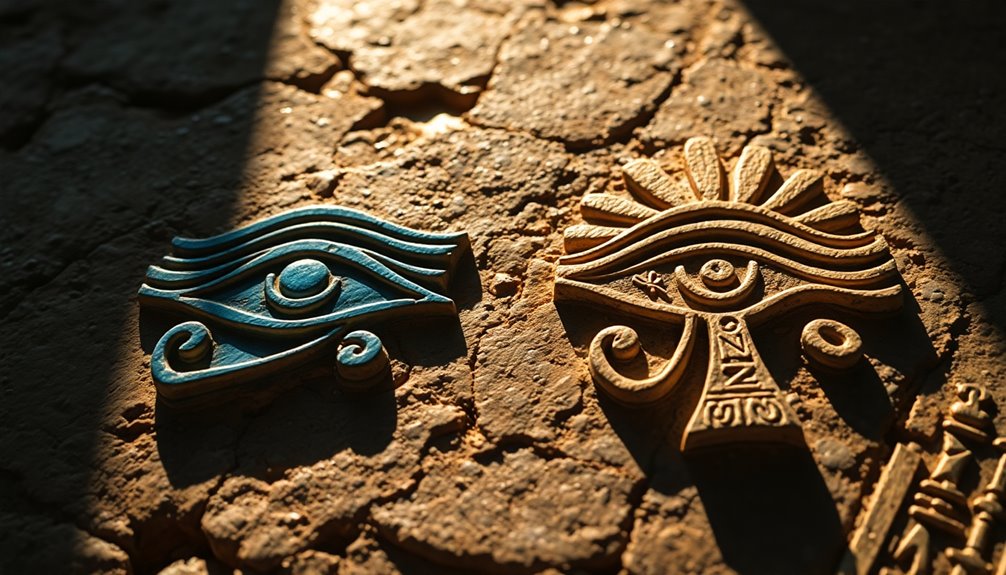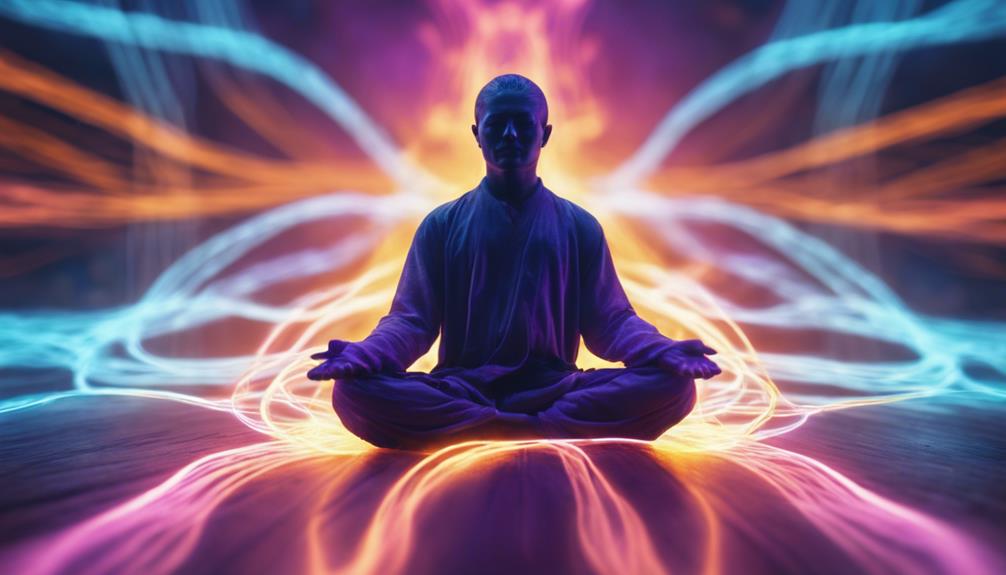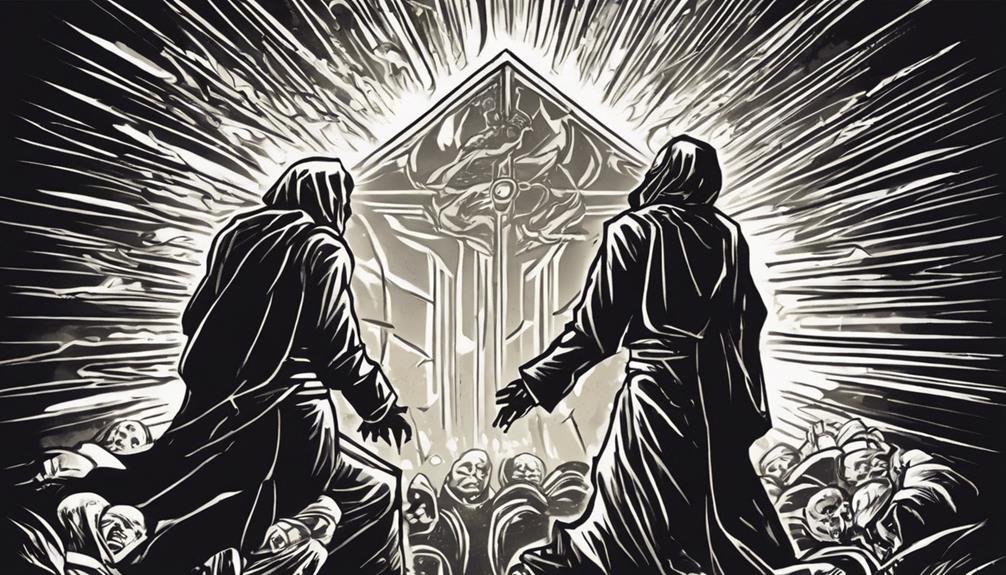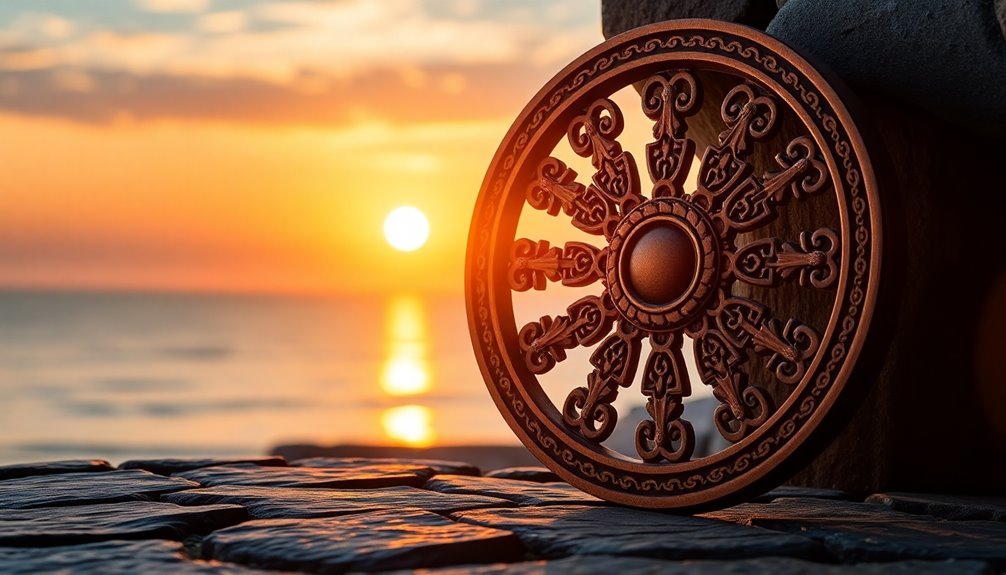The Eye of Horus and the Eye of Ra are intriguing symbols with rich and complex meanings. The Eye of Horus represents protection, healing, and completeness, while the Eye of Ra symbolizes chaos and divine retribution, often associated with the sun. You'll find both symbols throughout ancient Egyptian culture and in modern interpretations, like jewelry and tattoos. Their intertwined myths depict the struggle between order and chaos, showcasing their importance in connecting people to deities. These symbols spark debate among scholars, leaving you curious about their distinct roles in mythology and society. Discover more about their enthralling histories!
Key Takeaways
- The Eye of Horus symbolizes protection and healing, while the Eye of Ra represents chaos and divine retribution in ancient Egyptian mythology.
- Both symbols are interconnected, often depicted interchangeably, reflecting their duality in the context of ancient beliefs.
- The Eye of Horus is associated with royal power and completeness, contrasting with the Eye of Ra's solar connotations and destructive qualities.
- Cultural significance extends beyond Egypt, influencing neighboring regions and modern interpretations in tattoos, jewelry, and spiritual practices.
- Egyptologists emphasize the distinct roles of these eyes, with Horus representing restoration and balance, while Ra embodies consequences of divine disrespect.
Symbolism of the Eye of Horus
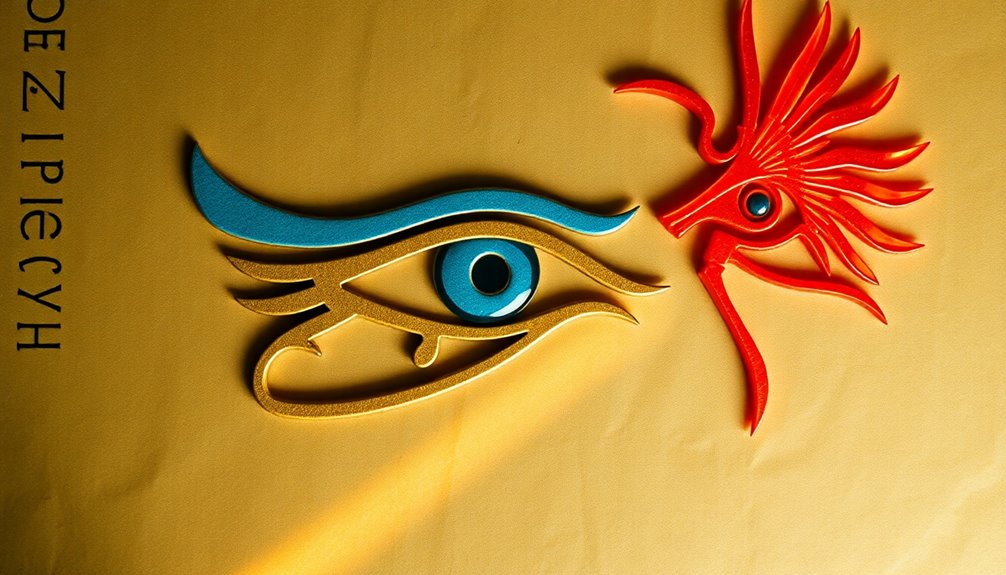
Although you might be familiar with various symbols, the Eye of Horus stands out for its deep-rooted significance in ancient Egyptian culture. This powerful emblem, also known as the Wadjet, symbolizes protection and healing, making it a crucial part of the ancient Egyptians' spiritual beliefs. The Eye of Horus is often depicted as a stylized human eye with markings reminiscent of a falcon, linking it to the sky god Horus.
The symbolism of the Eye of Horus extends beyond mere imagery; it connects to the myth of Horus and Osiris, where the eye's destruction and restoration represent the eternal struggle between chaos and order. Each component of the Eye corresponds to fractions in ancient Egyptian mathematics, signifying the limits of human perception and the six senses.
Ancient Egyptians frequently used the Eye of Horus in funerary practices and as amulets, believing it offered protection against the evil eye and guaranteed safe passage to the afterlife.
Even today, the Eye of Horus continues to embody healing and protection, appearing in modern jewelry and art across various cultures.
Myths of the Eye of Ra

The Eye of Ra, often seen as a fierce and protective force, symbolizes the dual nature of creation and destruction in ancient Egyptian mythology. This powerful symbol is frequently associated with the sun and embodies a destructive force, personified by the goddess Wadjet.
According to myth, Wadjet punishes humanity for disrespecting Ra, demonstrating the theme of divine retribution that permeates these tales. Ra wielded the Eye of Ra as a tool to release destruction, but notably, this fury could be calmed with offerings of beer and pomegranate juice.
This narrative illustrates the delicate balance between chaos and harmony, reinforcing the importance of maintaining cosmic order. The Eye of Ra is often depicted as a protective entity, highlighting its role in restoring balance after chaos ensues.
Moreover, the Eye of Ra and the Eye of Horus are sometimes portrayed interchangeably, reflecting their interconnected roles within Egyptian mythology. Together, they embody the essential themes of protection versus chaos, reminding you of the dynamic relationship between gods and the intricate balance between creation and destruction in ancient beliefs.
Eye of Horus in Jewelry
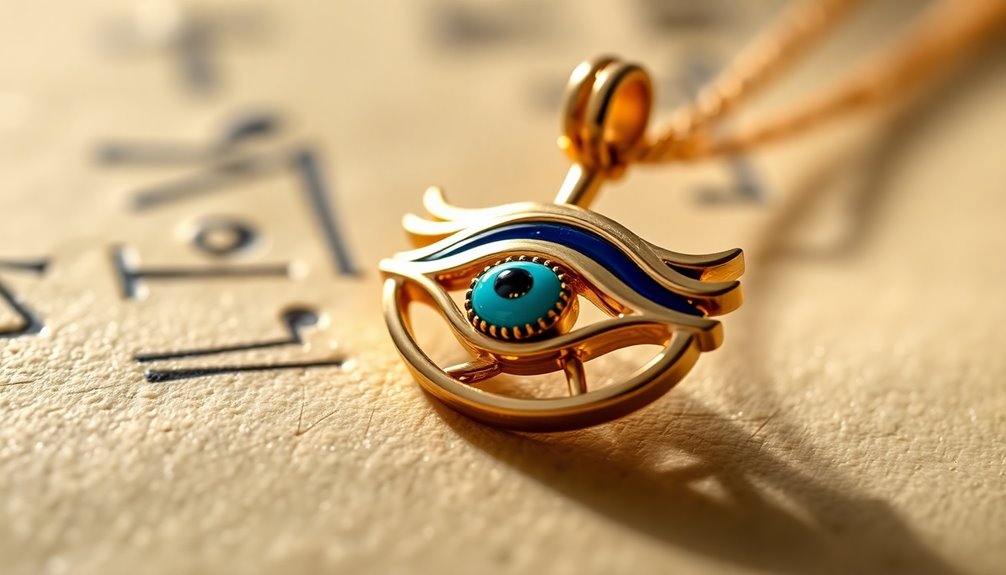
Eye of Horus jewelry has captivated people for centuries, symbolizing protection, healing, and royal power. This iconic Egyptian symbol is often crafted from gold, silver, and gemstones, making it a popular choice for unique jewelry pieces. You might find rings and pendants that creatively incorporate the Eye of Horus into their designs, ensuring a blend of ancient wisdom and modern aesthetics.
| Type of Jewelry | Symbolism | Materials Used |
|---|---|---|
| Rings | Protection and healing | Gold, silver, gemstones |
| Pendants | Spiritual connection and unity | Gold, silver, gemstones |
| Horeb Unification | Cosmic unity and integration | Gold, silver, unique stones |
These pieces often serve as protective talismans, gifted during significant life events like marriages or home purchases. For instance, the Horeb Unification pendant features the Eye of Horus within a triangle, representing the integration of mind, body, and spirit. The Eye of Horus remains a sought-after symbol in both spiritual and fashion contexts, reminding you of its enduring legacy and significance.
Cultural Significance of Symbols
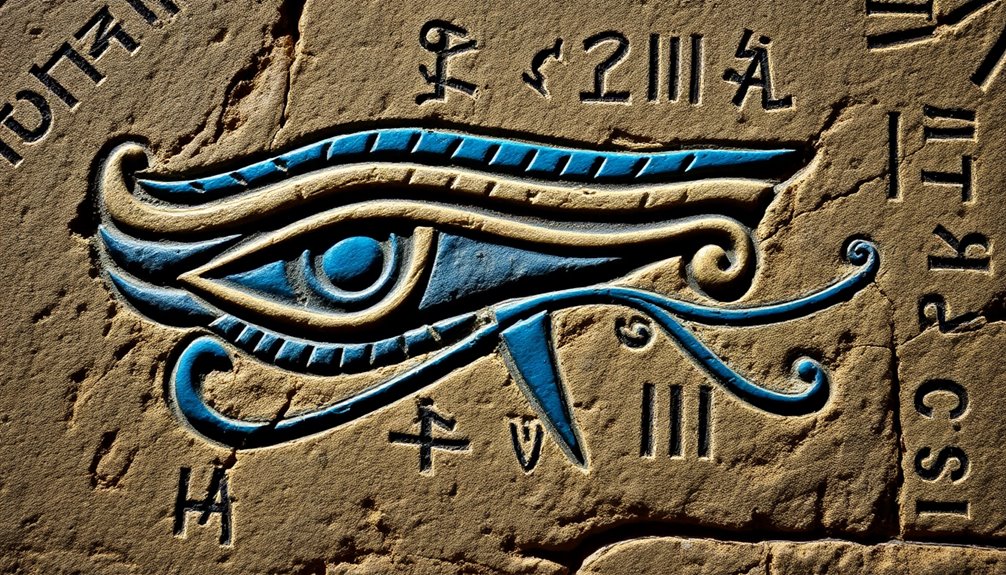
When you look at the Eye of Horus and Eye of Ra, you're seeing symbols steeped in rich historical context and origins.
These symbols played essential roles in daily life, influencing everything from art to belief systems in ancient Egypt.
Today, you can spot their modern interpretations in jewelry and popular culture, showcasing their lasting impact.
#
Historical Context and Origins
Cultural significance thrives in ancient symbols like the Eye of Horus and the Eye of Ra, each deeply rooted in Egypt's rich history.
The Eye of Horus symbol, known as the Wadjet, dates back to the Old Kingdom (c. 2686–2181 BC) and continued to hold importance well into the Roman period (30 BC – 641 AD). This enduring legacy highlights its role in funerary practices, where it was often featured on coffins and stone stelae, signifying protection for the deceased in the afterlife.
The Eye of Ra, frequently conflated with the Eye of Horus, embodies a duality in ancient Egyptian mythology, representing both protective qualities and destructive forces associated with the sun god Ra.
These symbols weren't just confined to Egypt; they gained prominence in neighboring cultures like Syria, Canaan, and Nubia, reflecting their broader significance.
Additionally, the Eye of Horus served as a prototype for funerary offerings, linking it to temple worship and spiritual beliefs surrounding death and resurrection.
In this way, both symbols encapsulate critical aspects of ancient Egyptian beliefs and practices, showcasing their profound cultural relevance.
Symbolism in Daily Life
Ancient symbols like the Eye of Horus and Eye of Ra have a powerful presence in daily life, influencing both personal and communal practices.
The Eye of Horus is a widely recognized symbol of protection, often found in Middle Eastern homes to ward off the evil eye associated with jealousy. You might notice it worn as jewelry during significant life events, symbolizing well-being and healing.
The Eye of Ra, on the other hand, represents a duality in its symbolism, embodying both a protective force and a destructive aspect linked to the sun. This complexity reflects how these Egyptian symbols resonate with various beliefs and practices in your daily life.
Consider these aspects of their cultural significance:
- Protection: The Eye of Horus serves as a safeguard in homes and during life milestones.
- Healing: Many associate these symbols with physical and emotional recovery.
- Spiritual Guidance: They provide spiritual symbols for contemplation and reflection.
- Cultural Heritage: These symbols connect you to ancient Egyptian beliefs and rituals.
Embracing these symbols in your life can deepen your understanding of their rich cultural significance.
Modern Interpretations and Uses
In today's world, the Eye of Horus and Eye of Ra resonate deeply with people seeking protection and healing. These ancient symbols have transcended their historical roots, finding new life in contemporary jewelry and modern aesthetics.
You'll often see them featured in tattoos and body art, reflecting a fascination with their spiritual meanings and rich cultural significance.
The Eye of Horus, in particular, is frequently invoked in spiritual practices. Many people turn to it for protection against the evil eye and to promote well-being, showcasing its enduring relevance in modern beliefs.
You might also notice the Eye of Horus being used in branding and design, symbolizing strength and safeguarding against negativity.
The cultural significance of these symbols is evident everywhere—from literature to art and popular media. They draw upon their mythological backgrounds, connecting us to ancient Egyptian civilization while adapting to contemporary contexts.
As you embrace these symbols, you not only connect with their protective and healing properties but also participate in a modern interpretation that honors their storied legacy.
## Historical Context and Origins

When you look at the Eye of Horus and Eye of Ra, you're exploring symbols deeply rooted in ancient Egyptian beliefs.
These eyes represented not just protection and power, but also the complex interplay of chaos and order in their mythology.
Understanding their origins reveals how these symbols shaped the cultural and religious landscape of ancient Egypt.
Ancient Egyptian Beliefs
While exploring the rich tapestry of ancient Egyptian beliefs, you'll find that symbols like the Eye of Horus and the Eye of Ra play pivotal roles in their mythology and religious practices.
The Eye of Horus, linked to the sky god Horus, symbolizes protection, healing, and royal power. In contrast, the Eye of Ra, associated with the sun god Ra, reflects a more destructive force. This duality showcases the Egyptians' understanding of life and chaos.
Key aspects of these symbols include:
- The Eye of Horus is often depicted in art, appearing on coffins and temple walls across centuries.
- The myth of Horus and Set emphasizes themes of struggle, with Horus's left eye representing restoration and balance.
- Both eyes have connections to other deities like Thoth and Osiris, highlighting their significance in the afterlife.
- Over time, interpretations of the Eye of Horus and the Eye of Ra have evolved, yet they remain essential to understanding ancient Egyptian cosmology.
Together, these beliefs reflect the deep connection the ancient Egyptians had with the concepts of sight, perception, and divine influence in their lives.
Symbolic Representations Explained
How did the Eye of Horus and Eye of Ra evolve into such powerful symbols in ancient Egyptian culture? The Eye of Horus, or *Wedjat*, emerged from the myth of Horus's battle with Set, symbolizing protection and healing.
Thoth's restoration of Horus's eye after its loss highlights its significance in Egyptian belief as a source of safety and wellness. You'll find historical references to this symbol dating back to the Old Kingdom, where it adorned coffins, amulets, and temple walls, reinforcing its protective qualities.
In contrast, the Eye of Ra embodies a raw, destructive force linked to the sun, represented by the goddess Wadjet. This symbol signifies the dual nature of Egyptian belief—protection intertwined with chaos.
Although these symbols were often used interchangeably, Egyptologists like Richard H. Wilkinson suggest distinct meanings evolved, particularly during the New Kingdom.
Both the Eye of Horus and Eye of Ra continue to resonate today, influencing modern interpretations of ancient Egyptian symbols. They encapsulate the timeless themes of protection, healing, and the cyclical nature of life and death, ensuring their place as enduring icons of Egyptian mythology.
Eye of Horus vs. Eye of Ra
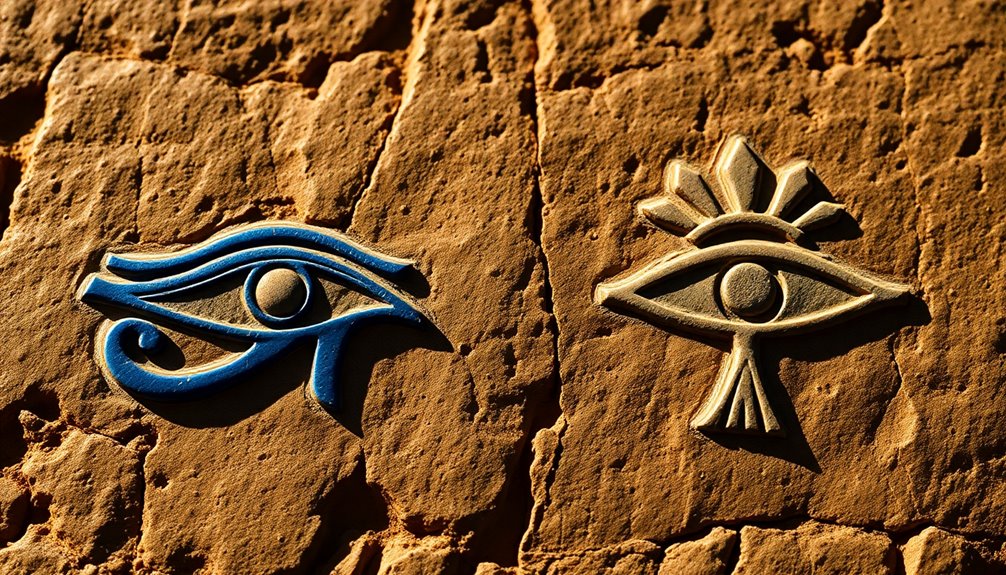
Both the Eye of Horus and the Eye of Ra hold significant meanings in ancient Egyptian culture, but they embody very different concepts. The Eye of Horus, or Udjat, symbolizes protection, healing, and royal power, often linked to the myth of Horus regaining his sight after battling Seth.
In contrast, the Eye of Ra represents a more destructive force associated with the sun god Ra, embodying chaos and punishment.
Here are some key differences between the two symbols:
- Eye of Horus: Associated with protection and healing.
- Eye of Ra: Linked to the sun god Ra and destruction.
- Deities: Both symbols connect to Osiris, Horus, and Ra but highlight different aspects.
- Symbolism: The Eye of Horus is often seen as a symbol of completeness, while the Eye of Ra reflects chaos.
While these symbols may sometimes be treated interchangeably, Egyptologists like Richard H. Wilkinson emphasize emerging distinctions, particularly separating the lunar aspects of the Eye of Horus from the solar connotations of the Eye of Ra.
Understanding these differences deepens your appreciation of ancient Egyptian culture.
Modern Interpretations and Usage

In today's world, the Eye of Horus has become a popular symbol in jewelry and fashion, representing protection, healing, and unity. You'll find it widely used in modern jewelry designs, often featured in rings and pendants that incorporate sacred geometry.
These pieces not only highlight ancient Egyptian artistry but also connect historical wisdom with contemporary aesthetics.
Many people wear Eye of Horus amulets as protective talismans against the evil eye. This reflects its historical significance in countering negative energies while enhancing overall well-being.
The spiritual significance of the Eye of Horus resonates deeply with those seeking a sense of security and balance in their lives.
While the Eye of Ra isn't as commonly depicted, it also finds its place in modern contexts, symbolizing strength and the duality of protection and destruction.
Both symbols inspire artistic motifs and tattoos in popular culture, chosen for their rich ties to ancient Egyptian mythology.
Impact on Egyptian Culture

The Eye of Horus and Eye of Ra deeply shaped ancient Egyptian culture, intertwining with religious beliefs and daily life. These powerful symbols represented crucial concepts such as protection and healing.
The Eye of Horus was often worn in amulets and included in funerary offerings, ensuring the deceased received divine safeguarding in the afterlife. Meanwhile, the Eye of Ra symbolized the destructive force of the sun, showcasing the ongoing battle between order and chaos.
Both symbols were essential in connecting the people to their gods and goddesses, where Horus represented the sky and Ra symbolized creation. Their presence in Egyptian art and architecture emphasized royal power and divine protection.
Here are some key points about their impact:
- The Eye of Horus served as a protective emblem in daily life.
- The Eye of Ra illustrated the consequences of disrespecting the divine.
- These symbols influenced numerous myths and religious practices.
- Their legacy continues to inspire modern interpretations related to healing and balance.
Ultimately, the Eye of Horus and Eye of Ra remain integral to understanding the complexities of ancient Egyptian culture.
Frequently Asked Questions
What Is the Negative Meaning of the Eye of Horus?
The Eye of Horus, while often seen as a symbol of protection, can also carry negative meanings.
You might find interpretations linking it to loss and suffering, especially since it represents the pain from Horus's battle with Set.
Additionally, if misunderstood, it could be misrepresented as a talisman for bad luck.
This duality reveals that the symbol's complexity can lead to associations with jealousy and malice, rather than just healing and protection.
What Is the Secret of the Eye of Horus?
Think of the Eye of Horus as your personal guardian angel, always watching over you.
The secret of this ancient symbol lies in its representation of protection, healing, and renewal. It's more than just a pretty design; it's a powerful emblem that reflects the ancient Egyptians' deep understanding of life and death.
Is the Eye of Horus Good or Bad?
You might see the Eye of Horus as a positive symbol, representing protection and healing.
It's often linked to safety, especially in funerary practices, where it safeguards the deceased.
While some may argue about its duality, you can generally consider it good because of its associations with well-being and order.
Its role in ancient Egyptian culture emphasizes its protective qualities, making it a comforting emblem rather than a negative force.
Is It Okay to Wear the Eye of Horus?
Wearing the Eye of Horus can be seen as a personal choice, and it often symbolizes protection and healing.
If you appreciate its historical significance and wear it respectfully, it can be a meaningful addition to your jewelry.
However, be mindful of its cultural origins and the perspectives of others.
Engaging with its symbolism thoughtfully can enhance your connection to its rich history while fostering respect for the cultures it represents.
Conclusion
In exploring the Eye of Horus and the Eye of Ra, you might find it fascinating how these ancient symbols continue to resonate today. Coincidentally, just as Egyptians once sought protection and healing through these eyes, you too may discover their meanings deepening your connection to history. Whether in jewelry or modern art, these symbols remind us of our shared human experience, bridging the past and present in ways that often surprise us.
